Quantum qubit-optical cavity node: Effects of the temperature and coupling strengths on the cavity Fock-state distribution occupation probability and entropy of the subsystems using Dicke model
IF 4.4
2区 物理与天体物理
Q2 MATERIALS SCIENCE, MULTIDISCIPLINARY
引用次数: 0
Abstract
One of the most attractive systems for scalable quantum processing is the trapped atom in the optical cavity, which is easily manipulable with lasers. The qubit cavity system represents an attractive structure for quantum optics, with possibilities for applications in quantum detecting, quantum computation, and quantum communication. In addition, the investigation of the cavity-atom system under temperature is a fundamental concept in quantum optics and quantum information science. Here we continue in this quantum way, investigating different qubit(s)-cavity systems (where we increase the numbers of the qubit inside the optical cavity from one to four). Using the Dicke model, we calculate the probability of occupation of the ground state of the cavity and the expectation values for each system. We find that these probabilities increase as the coupling strength increases. This leads to reaching the ultra-strong coupling regime, which depends on the number of qubits. To describe the quantum state, we examine the cavity Wigner function WF as a function of the coupling strength . Under the same parameters (e.g. and the dissipation rates), we find that the separation of the quantum state in the WFs representation is different from one system to another. Furthermore, since understanding these kinds of systems is very important in order to improve the quantum network system, we study the entropy of the subsystems (such as of qubit) in each system. Also, we move beyond by studying the effect of the temperature on the Fock-state distribution occupation probability and entropy of the subsystems. Our results present another step to understanding the qubit(s)-cavity interaction to improve the performance of future quantum networks based on this system. Where the interplay between temperature, coupling strengths, and the Fock-state occupation probabilities contributes significantly to the understanding of quantum decoherence and the thermodynamic properties of quantum systems. Our research on cavity qubit systems is crucial to the development and practical use of quantum networks, which will open the door to distributed quantum computing and other quantum technologies.
基于Dicke模型的量子量子位光腔节点:温度和耦合强度对子系统腔fock态分布、占用概率和熵的影响
最具吸引力的可扩展量子处理系统之一是在光学腔中捕获原子,它很容易被激光操纵。量子比特空腔系统代表了量子光学的一个有吸引力的结构,在量子探测、量子计算和量子通信方面具有应用的可能性。此外,温度下腔-原子系统的研究是量子光学和量子信息科学的一个基本概念。在这里,我们继续以这种量子方式,研究不同的量子比特腔系统(我们将光学腔内的量子比特数从一个增加到四个)。利用Dicke模型,我们计算了每个系统占据空腔基态的概率< a°†a°>,期望值< Jz >。我们发现这些概率随着耦合强度Cs的增加而增加。这将导致达到超强耦合状态,这取决于量子位的数量。为了描述量子态,我们研究了腔维格纳函数WF作为耦合强度Cs的函数。在相同的参数(如Cs和耗散速率)下,我们发现WFs表示中量子态的分离在不同的系统中是不同的。此外,由于了解这些类型的系统对于改进量子网络系统非常重要,因此我们研究了每个系统中子系统的熵S(例如量子比特的熵S)。此外,我们还进一步研究了温度对子系统的fock态分布、占用概率和熵的影响。我们的结果为理解量子比特(s)-腔相互作用提供了另一个步骤,以提高基于该系统的未来量子网络的性能。其中温度、耦合强度和fock态占据概率之间的相互作用有助于理解量子退相干和量子系统的热力学性质。我们对空腔量子比特系统的研究对量子网络的发展和实际应用至关重要,这将为分布式量子计算和其他量子技术打开大门。
本文章由计算机程序翻译,如有差异,请以英文原文为准。
求助全文
约1分钟内获得全文
求助全文
来源期刊

Results in Physics
MATERIALS SCIENCE, MULTIDISCIPLINARYPHYSIC-PHYSICS, MULTIDISCIPLINARY
CiteScore
8.70
自引率
9.40%
发文量
754
审稿时长
50 days
期刊介绍:
Results in Physics is an open access journal offering authors the opportunity to publish in all fundamental and interdisciplinary areas of physics, materials science, and applied physics. Papers of a theoretical, computational, and experimental nature are all welcome. Results in Physics accepts papers that are scientifically sound, technically correct and provide valuable new knowledge to the physics community. Topics such as three-dimensional flow and magnetohydrodynamics are not within the scope of Results in Physics.
Results in Physics welcomes three types of papers:
1. Full research papers
2. Microarticles: very short papers, no longer than two pages. They may consist of a single, but well-described piece of information, such as:
- Data and/or a plot plus a description
- Description of a new method or instrumentation
- Negative results
- Concept or design study
3. Letters to the Editor: Letters discussing a recent article published in Results in Physics are welcome. These are objective, constructive, or educational critiques of papers published in Results in Physics. Accepted letters will be sent to the author of the original paper for a response. Each letter and response is published together. Letters should be received within 8 weeks of the article''s publication. They should not exceed 750 words of text and 10 references.
 求助内容:
求助内容: 应助结果提醒方式:
应助结果提醒方式:


